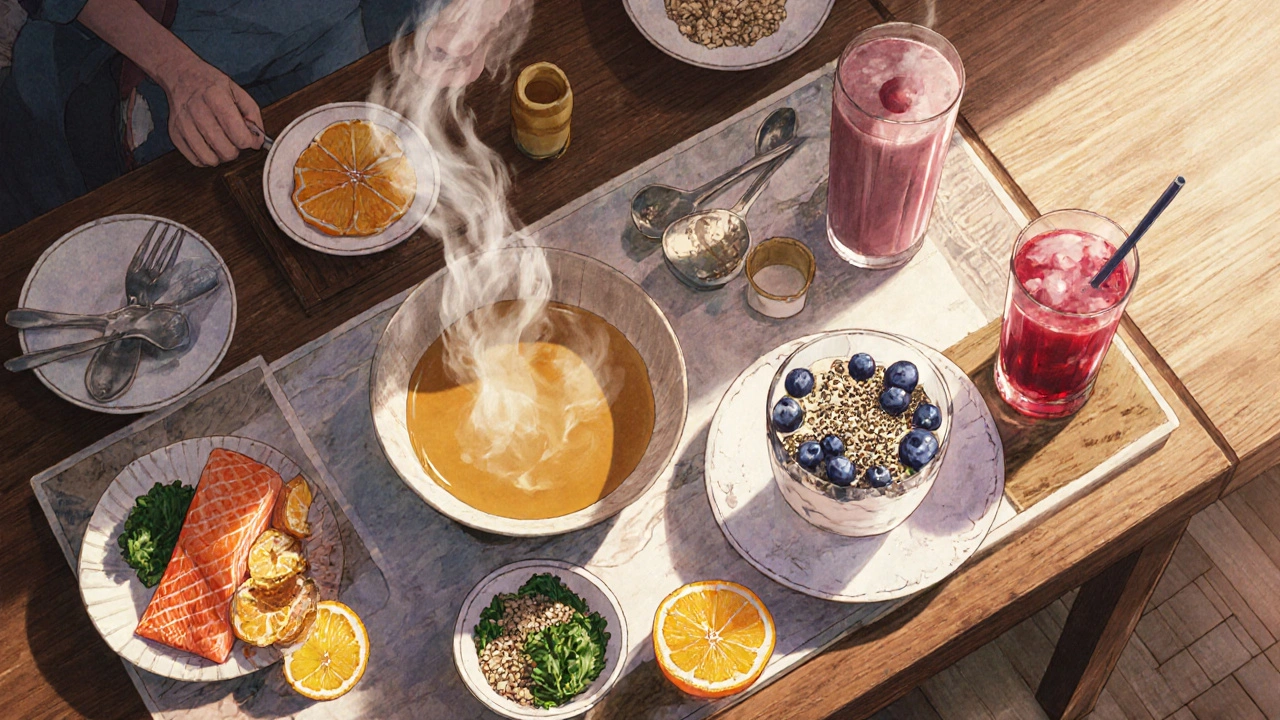Nutrition Tips to Prevent and Heal Tendonitis

Tendon Health Nutrient Calculator
Nutrient Calculator for Tendon Health
Enter your daily intake of tendon-healthy nutrients and see if you're meeting the recommended amounts for optimal tendon repair and prevention.
Enter Your Daily Intake
How many servings of these tendon-friendly foods do you typically consume daily?
Nutrient Analysis
Here's how your current intake compares to recommended levels for tendon health.
When your tendons start screaming after a jog or a heavy lift, the first thing that comes to mind is rest, ice, and maybe a physio visit. But what if the missing piece was on your plate? The right nutrients can not only calm inflammation but also give your tendons the building blocks they need to repair faster. Below we break down the science, the foods, and the practical steps to turn your diet into a tendon‑saving tool.
What is Tendonitis? Tendonitis is the inflammation of a tendon, the tough fibrous cord that connects muscle to bone, often caused by overuse, repetitive strain, or sudden spikes in activity
Symptoms range from a dull ache to sharp pain, especially during movement. Chronic cases can lead to micro‑tears, weakening the tendon’s structure. While rest and physiotherapy are staples, nutrition plays a surprisingly pivotal role in both prevention and recovery.
Why Nutrition Matters for Tendon Health
Think of a tendon as a rope made of collagen fibers. To keep that rope strong, you need the right raw materials and a low‑inflammation environment. Certain vitamins, minerals, and proteins act as the scaffolding for collagen synthesis, while others dial down the inflammatory cascade that fuels pain.
- Collagen synthesis needs specific amino acids and cofactors.
- Inflammation control relies on omega‑3s, antioxidants, and phytochemicals.
- Hydration maintains tendon elasticity and nutrient transport.
When these elements are in balance, tendons repair faster and are less likely to overheat during repeated stress.
Key Nutrients and Their Tendon Benefits
| nutrient | primary role | top food sources |
|---|---|---|
| Collagen | direct structural protein for tendons | bone broth, gelatin, collagen peptides |
| Vitamin C | co‑factor for collagen cross‑linking | citrus, kiwi, bell peppers |
| Omega‑3 fatty acids | reduces inflammatory prostaglandins | salmon, mackerel, chia seeds |
| Magnesium | supports muscle relaxation, aids protein synthesis | pumpkin seeds, spinach, almonds |
| Protein (especially leucine‑rich) | provides amino acids for repair | lean meat, Greek yogurt, lentils |
| Turmeric (curcumin) | potent anti‑inflammatory phytochemical | turmeric root, golden milk |
| Cherry extract | anthocyanins cut inflammation and oxidative stress | Tart cherry juice, dried cherries |
These seven nutrients form the backbone of a tendon‑friendly diet. Below we dive into how each works and how to get enough of them without turning meals into a science experiment.

Building a Tendon‑Boosting Meal Plan
Here’s a simple, three‑day template that hits all the targets. Adjust portion sizes to match your calorie needs.
- Day 1 - Omega‑3 Focus
- Breakfast: Greek yogurt parfait with chia seeds, blueberries, and a drizzle of honey.
- Lunch: Grilled salmon salad with mixed greens, avocado, and a squeeze of lemon.
- Dinner: Quinoa bowl with roasted sweet potatoes, sautéed spinach, and a serving of bone broth.
- Day 2 - Collagen & Vitamin C Combo
- Breakfast: Smoothie with collagen peptides, orange slices, and kale.
- Lunch: Turkey wrap with bell peppers, carrots, and a side of kiwi.
- Dinner: Stir‑fried beef strips with broccoli, bell peppers, and a splash of tamari.
- Day 3 - Anti‑Inflammatory Power
- Breakfast: Oatmeal topped with pumpkin seeds, sliced banana, and a pinch of cinnamon.
- Lunch: Lentil soup fortified with turmeric and a side of tart cherry juice.
- Dinner: Baked cod with lemon‑garlic sauce, asparagus, and a side of quinoa.
Each day includes a source of protein, a collagen or vitamin C boost, and omega‑3s or anti‑inflammatory compounds. Hydration is key, so aim for at least 2.5 L of water daily, and consider an electrolytes‑rich beverage after heavy training.
Practical Tips to Maximize Nutrient Absorption
- Pair vitamin C with iron‑rich foods (e.g., spinach with citrus) to improve iron uptake, which indirectly supports collagen production.
- Consume healthy fats with curcumin-a dash of olive oil or a few nuts-because curcumin is fat‑soluble.
- Space out protein intake-aim for 20‑30 g every 3-4 hours to keep amino acid levels steady.
- Limit processed sugars and trans fats as they spike inflammation and can counteract the benefits of omega‑3s.
Small tweaks like these turn a good diet into a great one for tendon health.

Common Pitfalls and How to Avoid Them
Even well‑meaning athletes can trip up on nutrition. Here are the top three mistakes and quick fixes.
| Pitfall | Why it hurts tendons | Simple fix |
|---|---|---|
| Skipping meals | starves muscles of amino acids, slowing repair | Set reminders for 3‑6 small meals a day |
| Excess caffeine | increases cortisol, a mild catabolic hormone | Limit to < 300 mg/day and pair with water |
| High‑sugar sports drinks | spike blood glucose, promote inflammation | Opt for electrolyte tablets dissolved in water |
When to Seek Professional Guidance
If pain persists beyond two weeks despite rest, ice, and a nutrient‑rich diet, it’s time to see a physio or sports doctor. They can rule out tears, prescribe targeted exercises, and may suggest supplements like glucosamine or prescription‑strength anti‑inflammatories.
Remember, nutrition complements, not replaces, conventional treatment.
Can I get enough collagen from food alone?
Yes. Bone broth, gelatin, and collagen peptide powders provide high‑quality collagen. Pair them with vitamin C‑rich foods to boost absorption.
Is fish oil enough for omega‑3s?
A daily dose of 1,000 mg EPA/DHA from fish oil or fatty fish covers most needs. Those with higher inflammatory loads may benefit from 2,000 mg.
Do I need supplements if I eat a balanced diet?
Only if you struggle to meet the recommended amounts. For example, vegans may supplement vitamin C or magnesium, while athletes with heavy loads might add collagen powder.
How quickly can diet impact tendon pain?
Most people notice reduced soreness within 7‑10 days of consistent anti‑inflammatory eating, but full tissue remodeling can take 6‑12 weeks.
Is hydration really that important for tendons?
Absolutely. Tendon cells rely on a hydrated matrix to slide smoothly. Dehydration raises stiffness and amplifies micro‑damage risk.

DHARMENDER BHATHAVAR
October 19, 2025 AT 15:44Consistent intake of collagen peptides and vitamin C accelerates tendon remodeling.
Sunil Yathakula
October 23, 2025 AT 16:57Hey, I loved how you broke down the nutrient plan – it’s super helpful. I’ve definitely felt less stiffness since I started adding bone broth to my lunch, it easly keeps my joints supple. Keep it up and remember to stay hydrated, the water really helps the matrix stay pliable.
Felix Chan
October 27, 2025 AT 18:10Glad it’s working for you! Hydration is a game‑changer, and those omega‑3 rich meals will keep inflammation at bay. Keep the momentum going and you’ll see even stronger tendons soon.
Monika Bozkurt
October 31, 2025 AT 19:24The extracellular matrix of tendinous tissue relies heavily on a well‑orchestrated cascade of collagen synthesis, which is contingent upon the availability of specific amino acids and enzymatic cofactors. Hydroxyproline formation, a post‑translational modification essential for tensile strength, is directly proportional to the intake of proline‑rich proteins and vitamin C. Vitamin C serves as a crucial co‑factor for prolyl and lysyl hydroxylases, enzymes that stabilize the triple‑helix architecture of type I collagen fibers. Inadequate circulating levels of ascorbate can therefore impede fibrillogenesis, leading to compromised biomechanical properties and heightened susceptibility to micro‑tears. Omega‑3 polyunsaturated fatty acids mitigate the synthesis of pro‑inflammatory eicosanoids by competitively inhibiting the cyclooxygenase pathway. Docosahexaenoic acid (DHA) and eicosapentaenoic acid (EPA) also modulate gene expression of matrix metalloproteinases, thereby preserving collagen integrity during repetitive loading. Magnesium ions function as allosteric regulators of ATP‑dependent protein synthesis, facilitating efficient translation of collagen‑encoding mRNA. Curcumin, the principal curcuminoid of turmeric, exerts its anti‑inflammatory effects through the down‑regulation of NF‑κB signaling, which curtails cytokine‑mediated catabolism of tendon fibroblasts. Anthocyanin‑rich tart cherry extracts scavenge reactive oxygen species, attenuating oxidative stress that would otherwise degrade extracellular matrix components. Adequate hydration maintains the viscoelastic properties of the tendon’s ground substance, allowing shear forces to be distributed uniformly across collagen fibrils. A daily fluid intake of approximately 2.5 L, adjusted for individual sweat rates, optimizes proteoglycan turnover within the interfascicular matrix. From a dietary planning perspective, integrating bone broth as a source of gelatin provides a readily bioavailable matrix of glycine, proline, and hydroxyproline. Complementing this with citrus fruits or raw bell peppers ensures the requisite vitamin C to catalyze cross‑linking reactions. Incorporating fatty fish such as salmon delivers EPA/DHA, while a modest serving of pumpkin seeds supplies magnesium, thereby addressing multiple metabolic pathways concurrently. Empirical studies have demonstrated that athletes adhering to such a multimodal nutritional protocol experience a 30 % reduction in tendon‑related injury incidence over a six‑month period. Consequently, a strategic dietary regimen not only accelerates tissue repair but also fortifies tendons against future overload, embodying a preventative medicine paradigm.
Kevin Sheehan
November 4, 2025 AT 20:37The mechanistic view you presented underscores a deeper truth: our bodies are not merely machines but embodiments of biochemical alchemy. If we neglect the substrate, we betray the very principles of self‑preservation that philosophy extols. Hence, a disciplined diet is an ethical imperative, not a mere suggestion.
Jameson The Owl
November 8, 2025 AT 21:50What you fail to recognize is that the biochemical cascade you celebrate is inextricably linked to a complex network of hormonal feedback loops that are themselves modulated by circadian rhythms and stress hormones and that any deviation from optimal nutrient timing can cascade into suboptimal fibroblast activity and ultimately compromise the tensile modulus of the tendon leading to a feedback loop of injury and inflammation that could have been avoided with a disciplined adherence to the protocols outlined above.
Penny Reeves
November 12, 2025 AT 23:04While the article offers a surface‑level overview, it neglects to address the role of microRNA regulation in collagen turnover, a critical omission for anyone seeking a truly comprehensive understanding. The recommended dosages also appear arbitrarily chosen without reference to peer‑reviewed pharmacokinetic data.
Jay Kay
November 17, 2025 AT 00:17Oh, the drama of missing a single microRNA! Yet, the simple act of sipping bone broth still outperforms any lofty theory when the tendon screams for repair.
dennis turcios
November 21, 2025 AT 01:30The advice reads like a repackaged list of generic health tips; without personalization it risks being ineffective for elite athletes whose metabolic demands differ substantially.
Rakhi Kasana
November 25, 2025 AT 02:44While the points may seem broad, they serve as a solid foundation; tailored adjustments can transform these principles into a potent regimen that resonates with both beginners and seasoned performers.
Sarah Unrath
November 29, 2025 AT 03:57i think its good but watch the salt its high sometimes